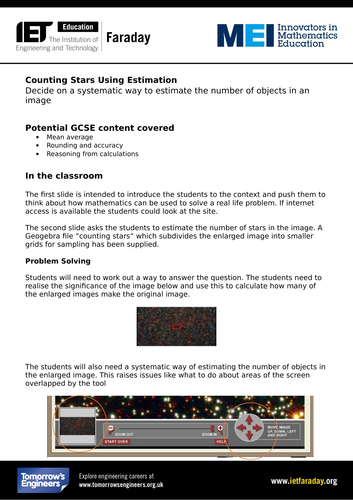



Decide on a systematic way to estimate the number of objects in an image
In this engaging STEM activity, designed for secondary school students, learners will take images from the Hubble telescope and use them to estimate the number of stars contained in those images.
Activity: Counting stars using estimation
The first slide in the presentation below introduces students to the context of the challenge and pushes them to think about how mathematics can be used to solve a real-life problem.
The second slide asks the students to estimate the number of stars in the image. A Geogebra file “counting stars” which subdivides the enlarged image into smaller grids for sampling has been supplied.
Students will need to find a systematic way of estimating the number of objects in the enlarged image.
One approach is to subdivide the enlarged image into smaller sections, count some of these and work out the mean. This mean can then be taken as the number of objects per subsection and multiplied by the number of subsections to get an estimate of the number of objects in the enlarged image.
To obtain an estimate for the number of stars in the original image, this figure then needs to be multiplied by the number of enlarged images in the original image.
Students will need to consider when to round off and what degree of accuracy is appropriate.
Discussion points
Comparing the different estimates obtained by the students would be interesting. Looking at the differences in their estimates for the number of objects in the enlarged image first and then observing how this transferred to the differences in the original image.
Extending the problem
This method is used in a wide variety of contexts, from estimating the number of hairs on someone’s head to auditing the number of insects in an enclosure at a zoo.
This activity could be extended by looking at capture/recapture as a method of estimating animal populations.
Potential GCSE content covered
In this activity students will cover mean average, rounding and accuracy and reasoning from calculations.
All activity sheets and supporting resources are free to download, and all the documents are fully editable, so you can tailor them to your students’ and your schools’ needs.
The activity sheet includes teacher notes, guidance, useful web links, and links (where appropriate) to the national curriculum in each of the four devolved UK nations; England, Northern Ireland, Scotland and Wales.
Please share your classroom learning highlights with us @IETeducation
Something went wrong, please try again later.
This is a lovely way to discuss estimation, accuracy, means and assumptions. The rest of the resources for this task can be found here:https://faraday-secondary.theiet.org/resource-pages/counting-stars-using-estimation/
Report this resourceto let us know if it violates our terms and conditions.
Our customer service team will review your report and will be in touch.